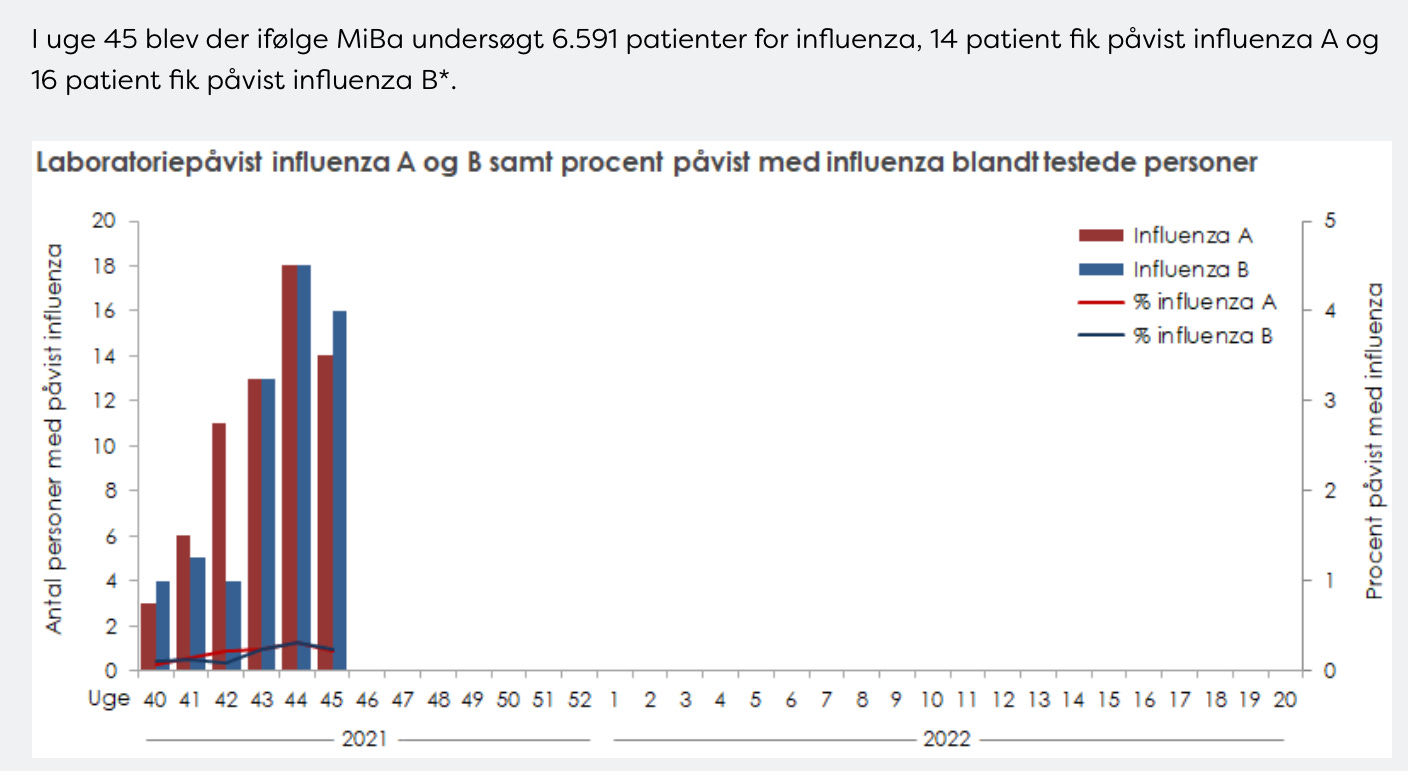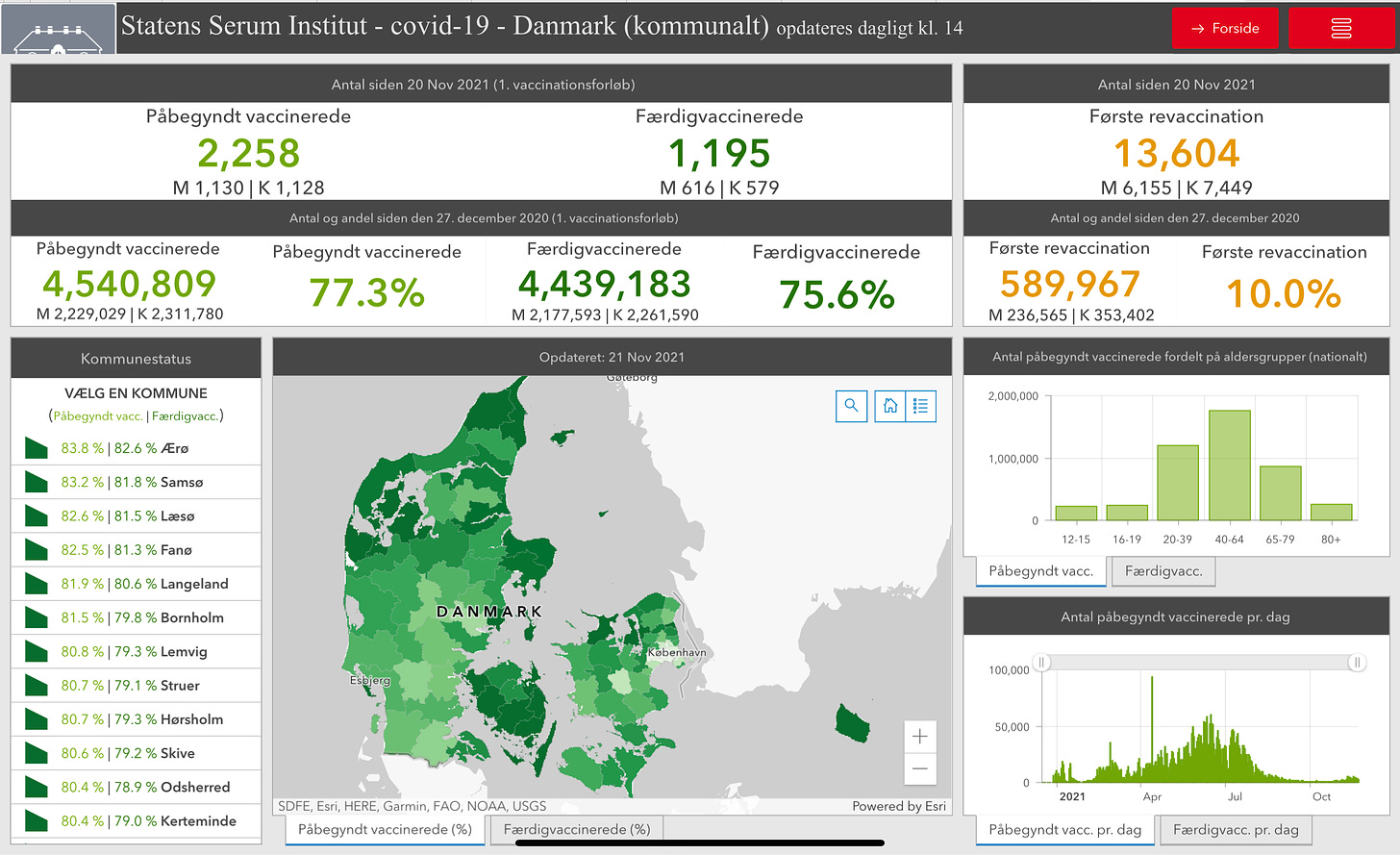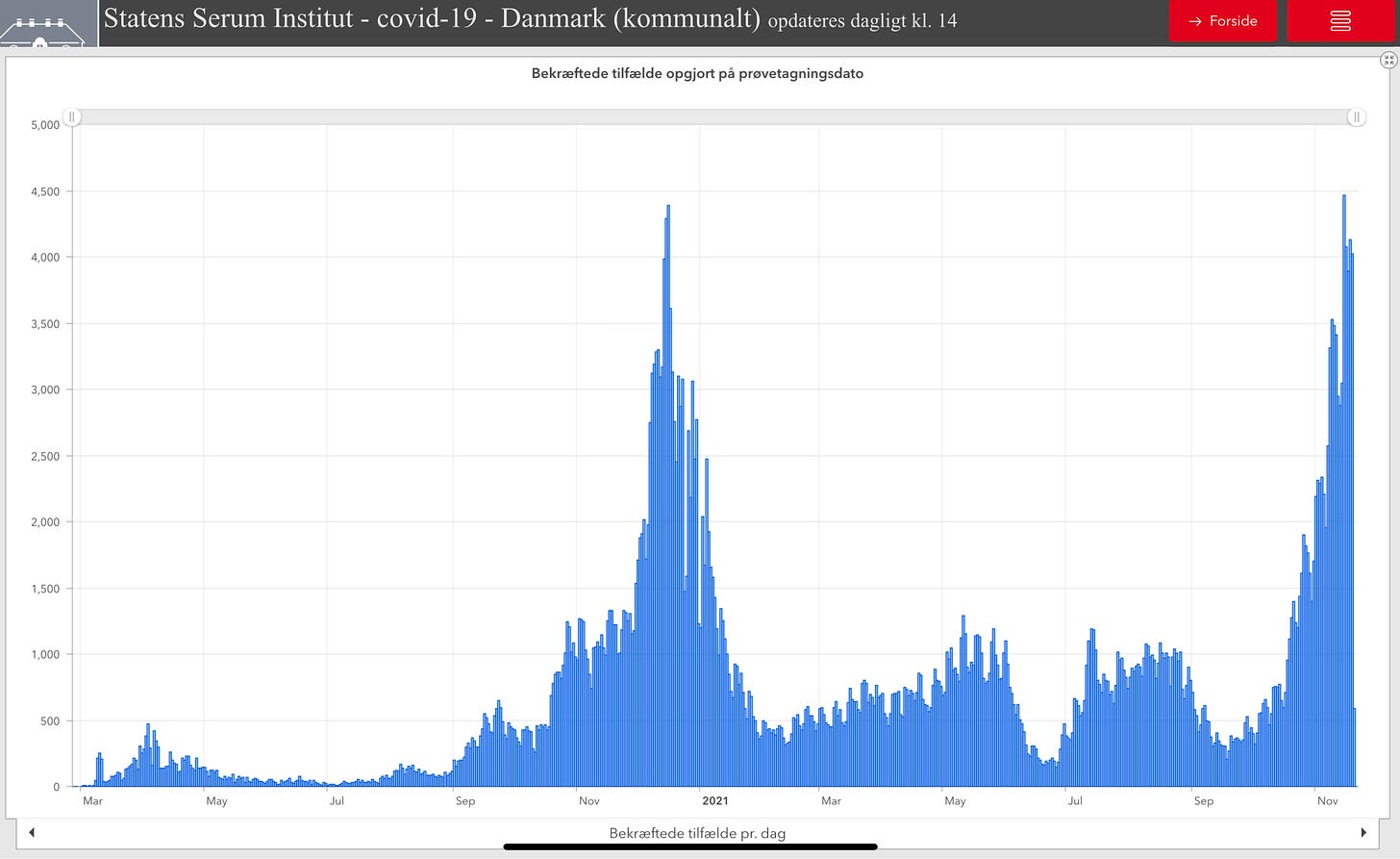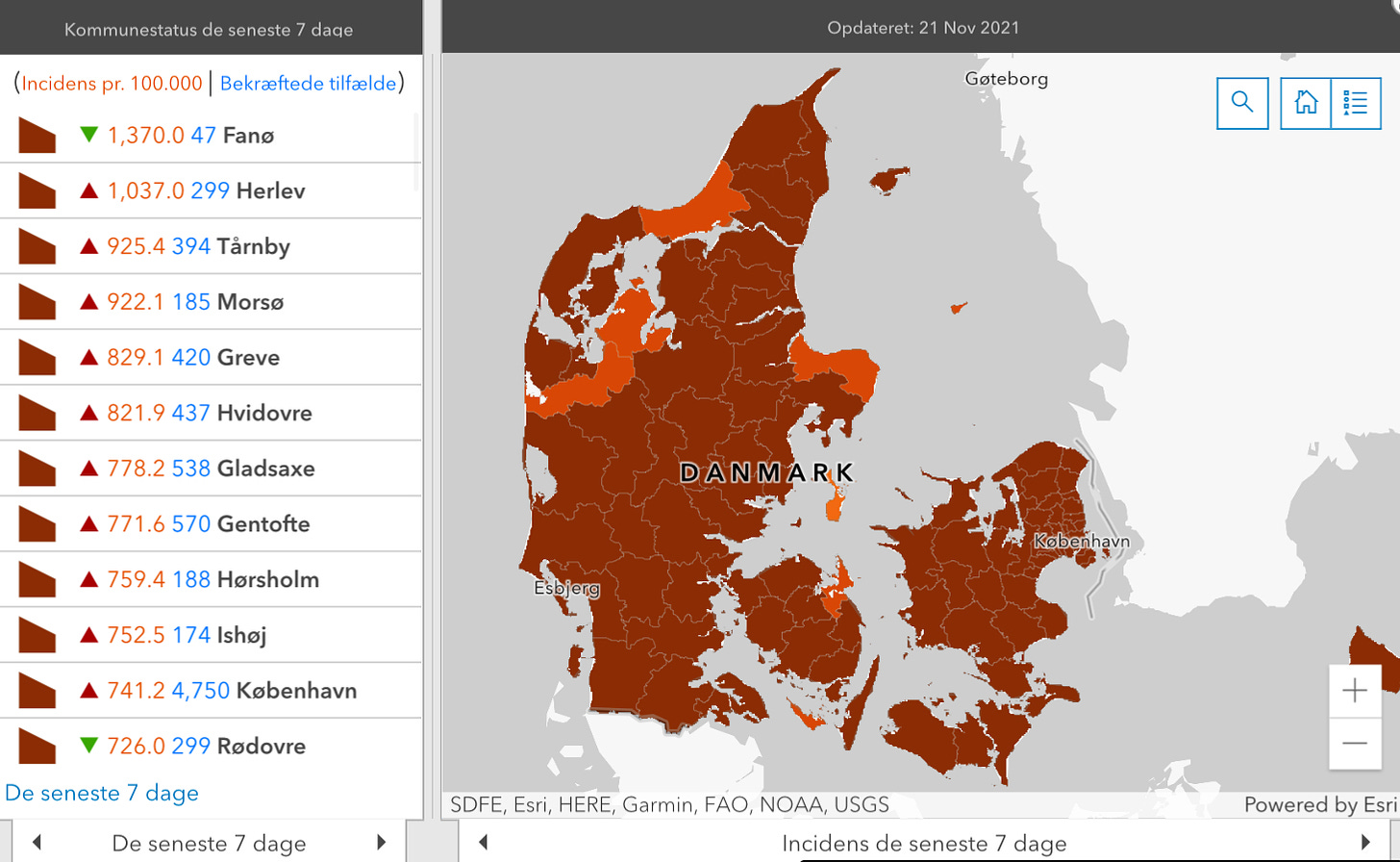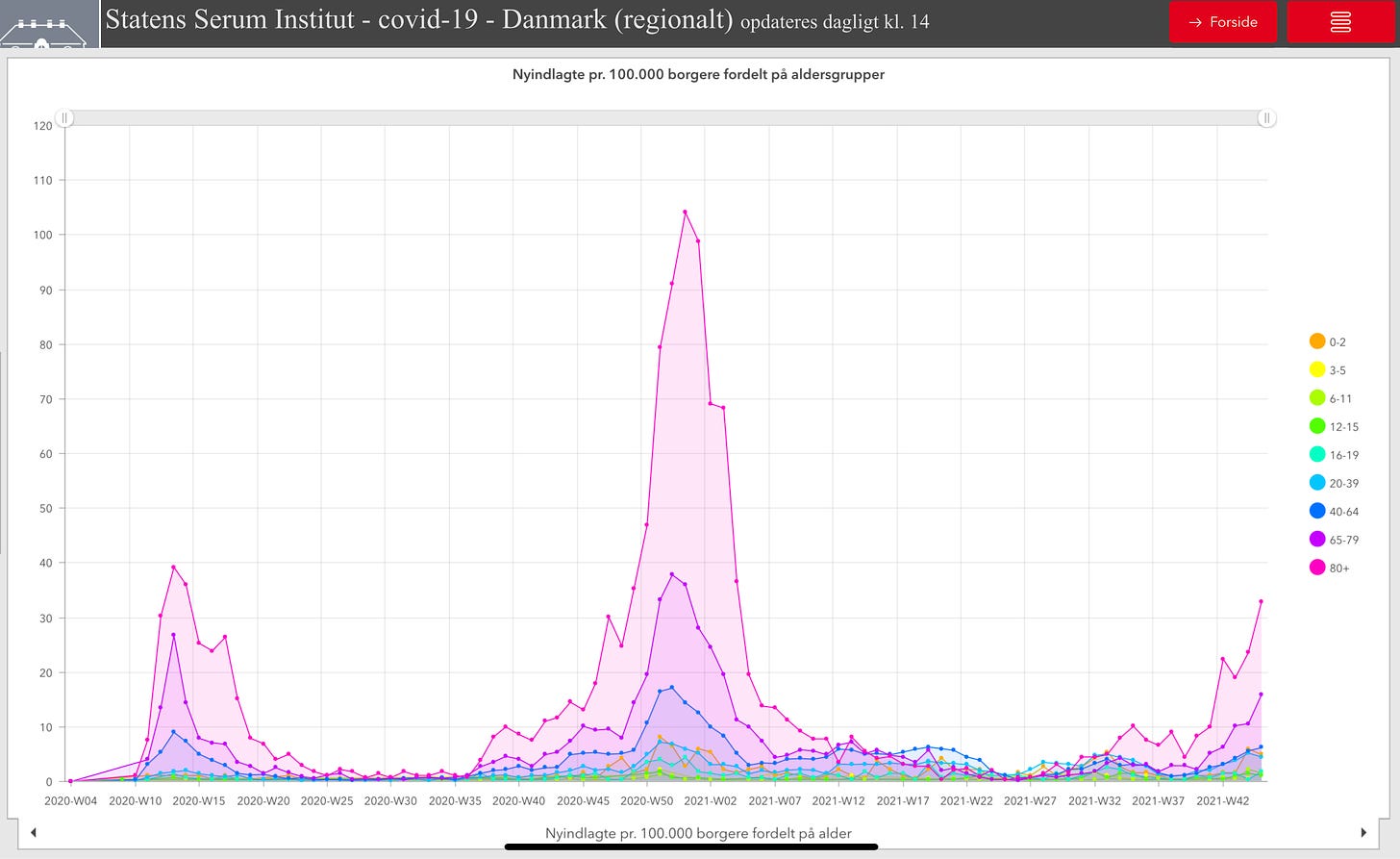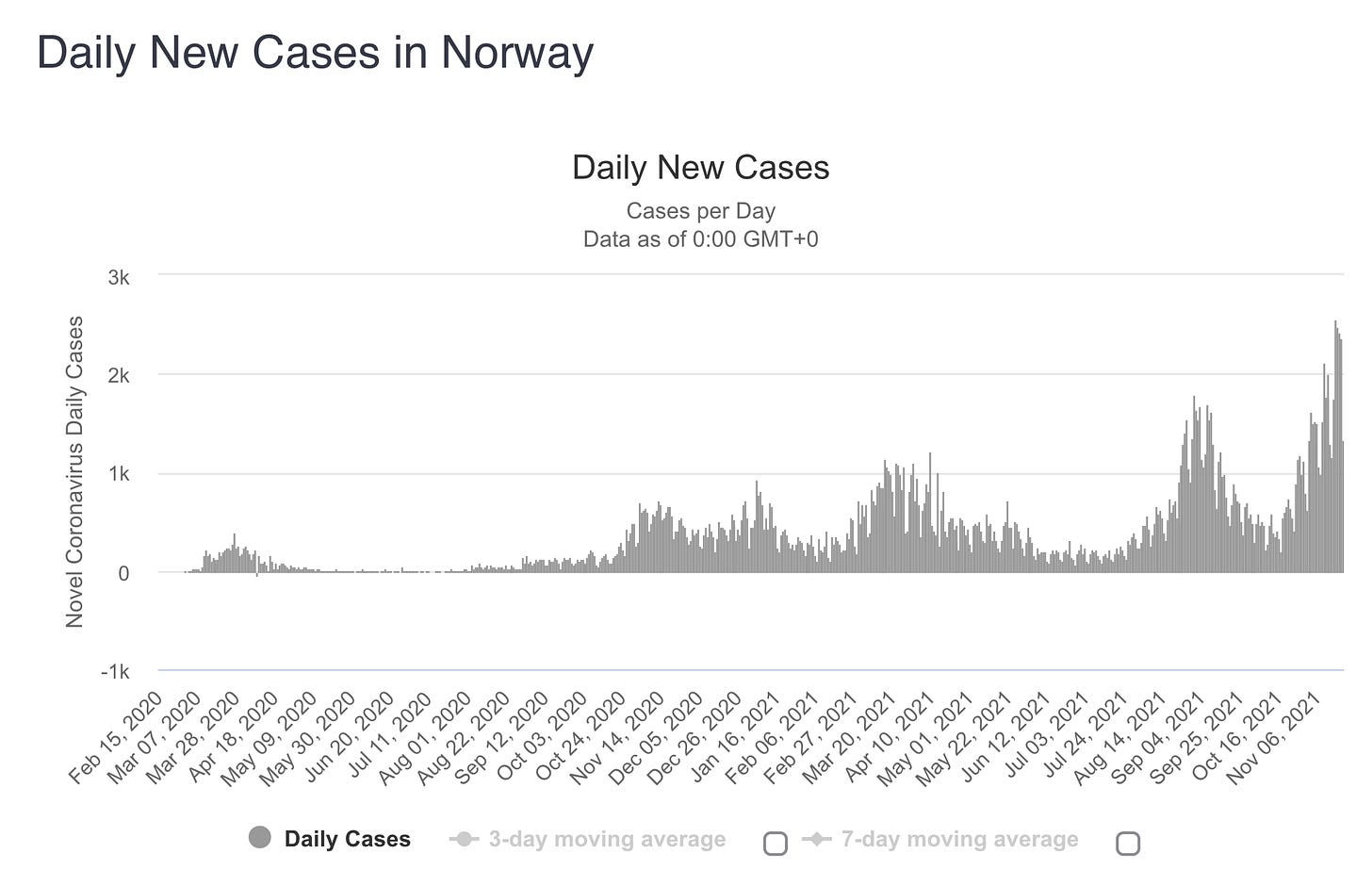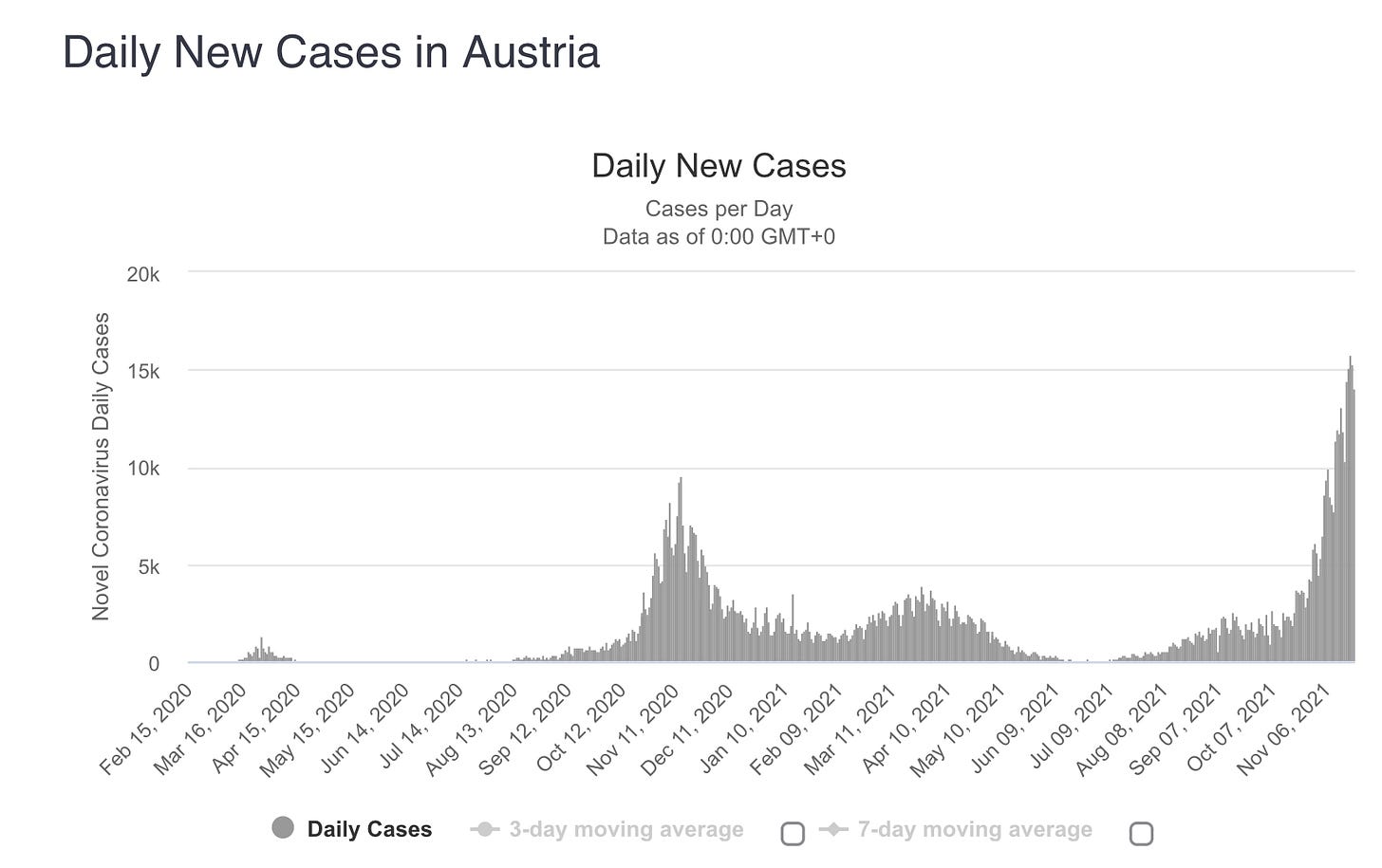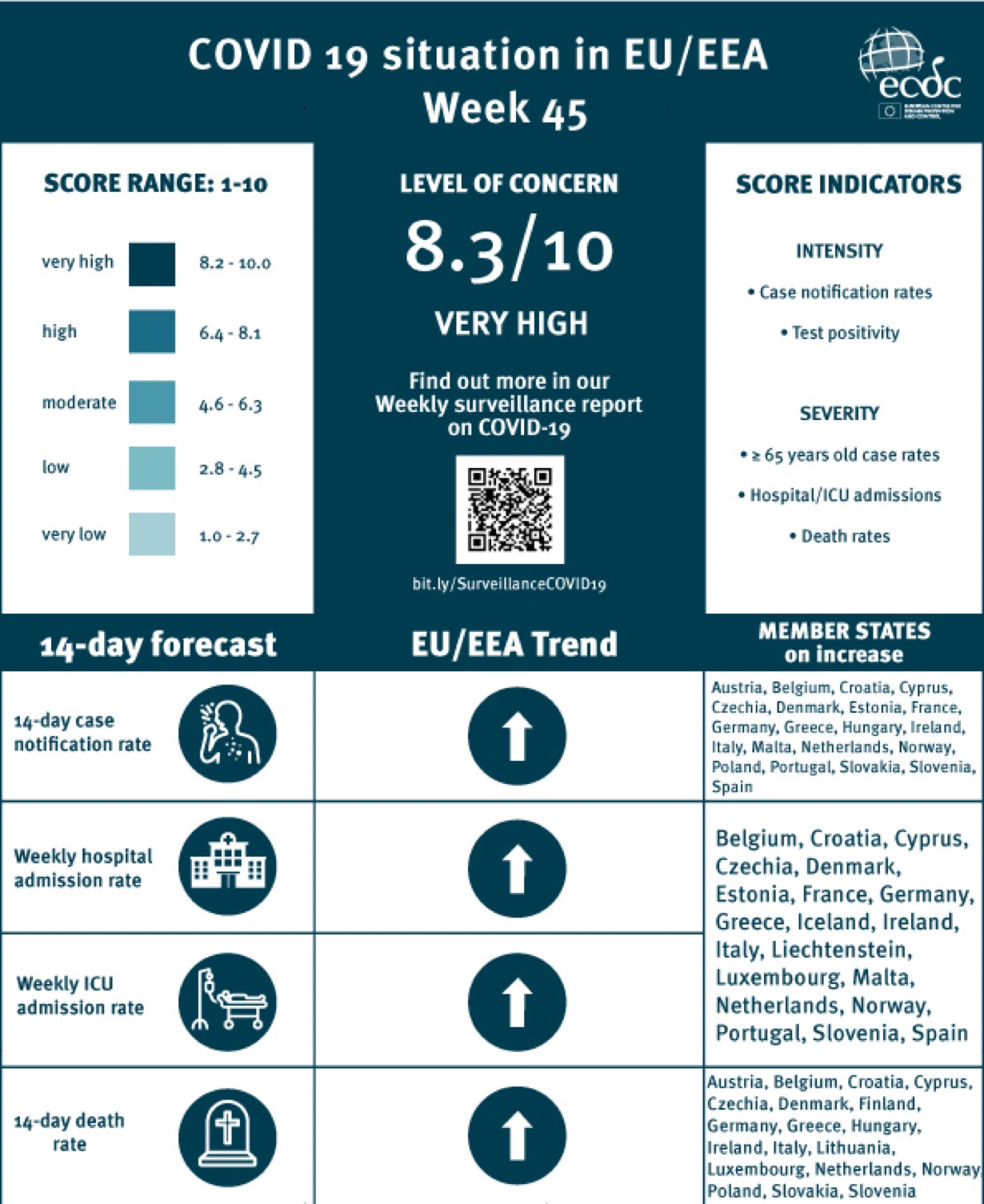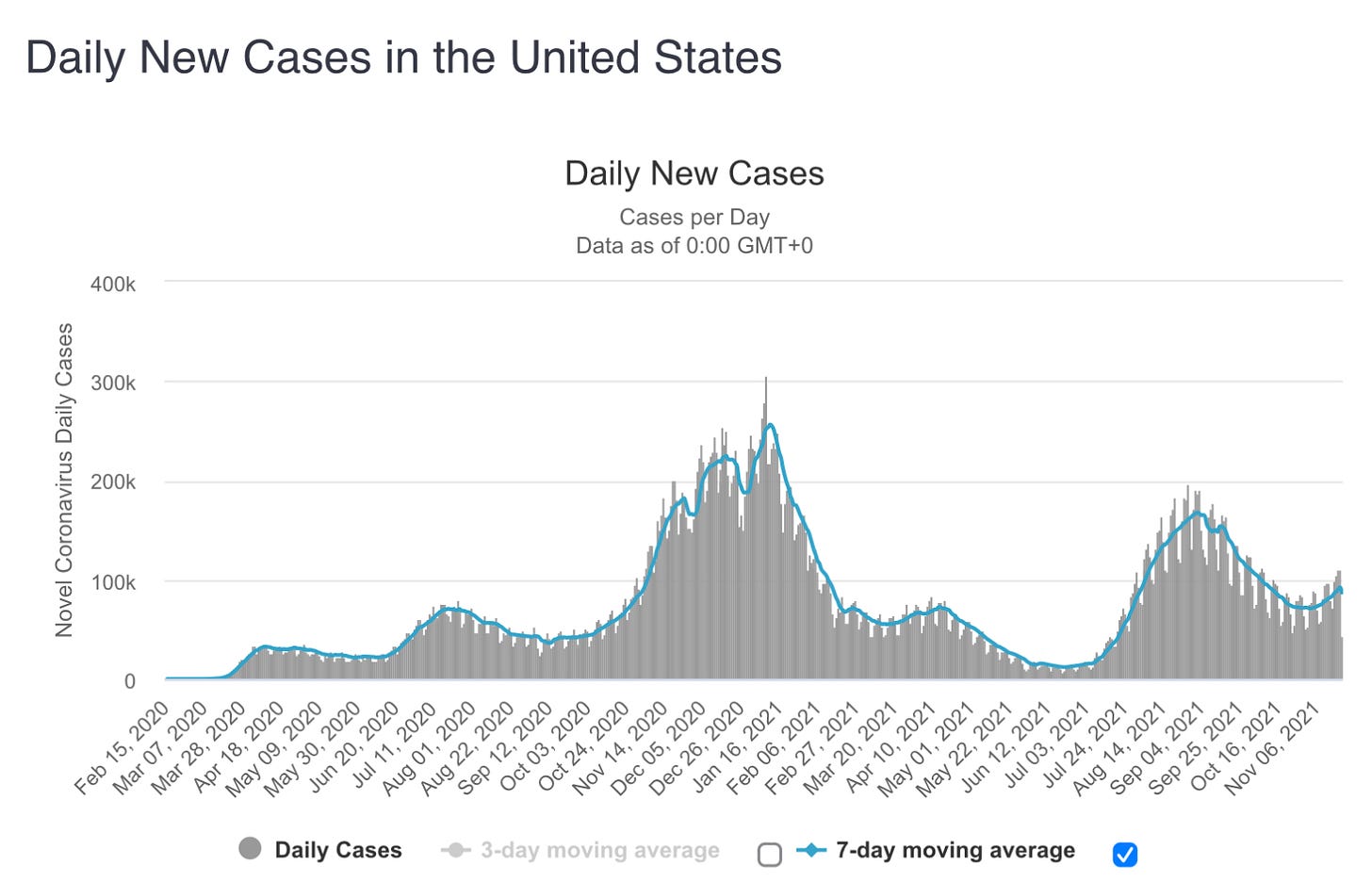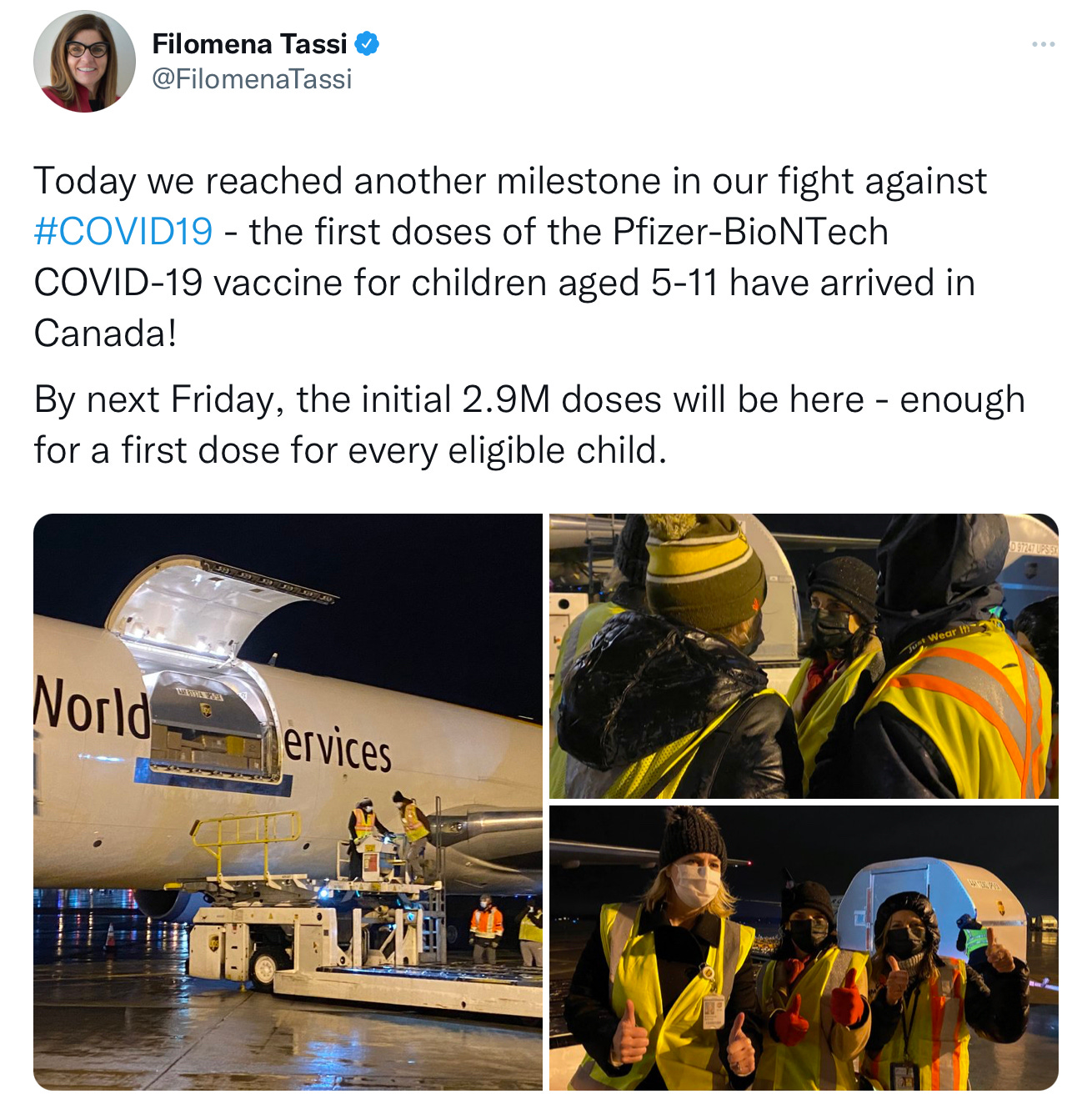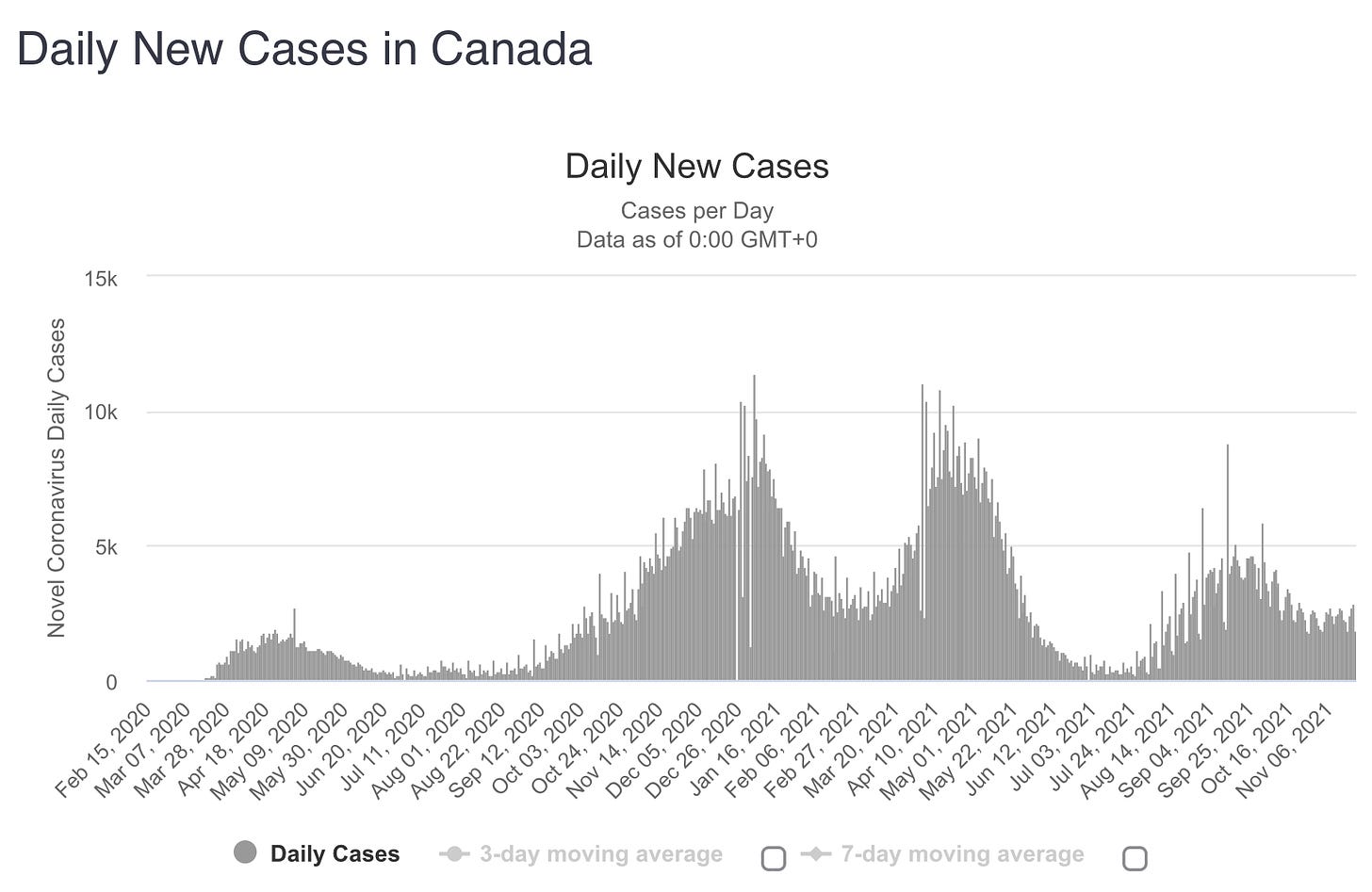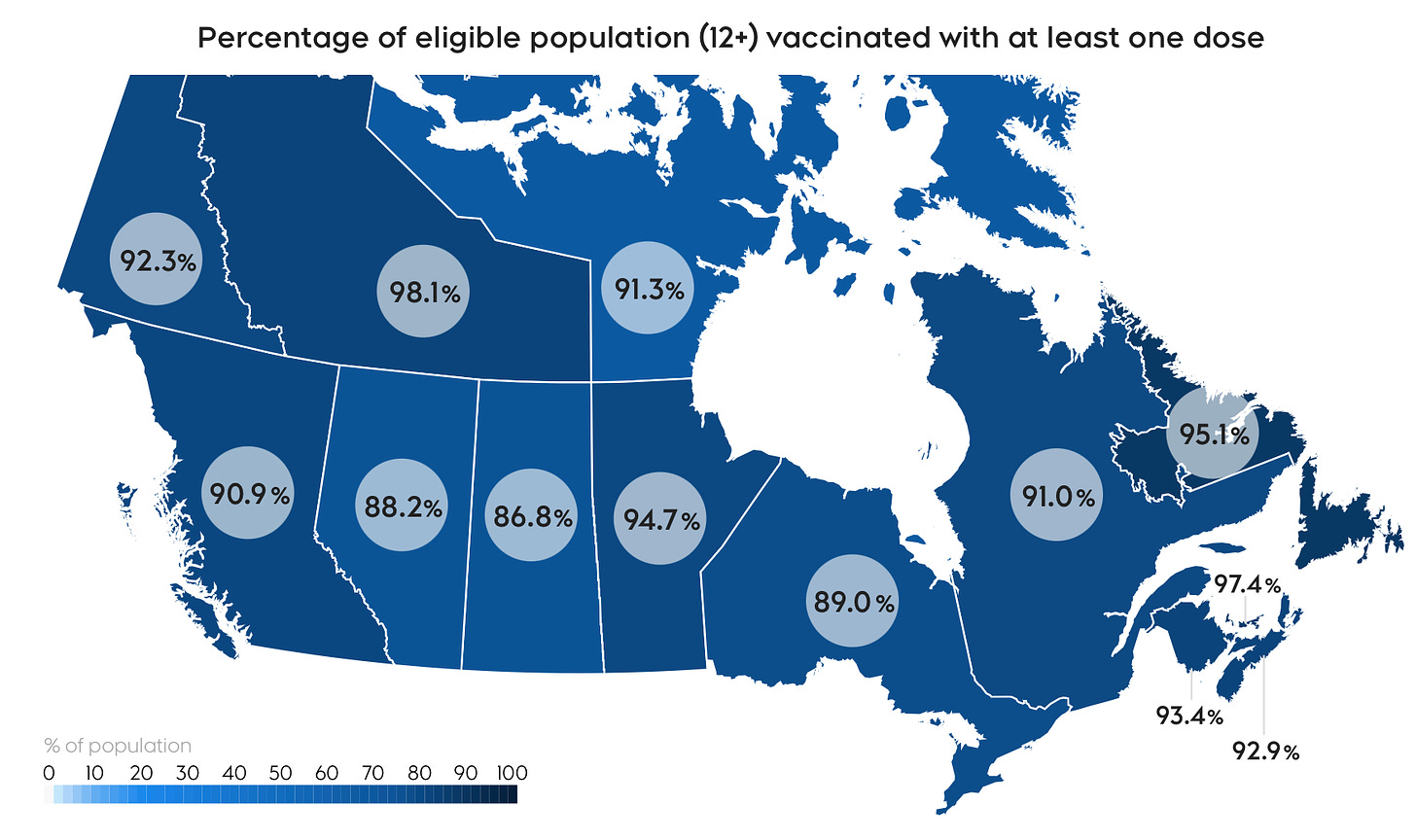Monday Morning News & Notes
COVID numbers mount in Denmark as one health region pulls the emergency brake
🇩🇰
Hospitals in Region Syddanmark are facing a capacity crunch and the region is now pulling the emergency brake. This means hospitals in Southern Denmark have now begun postponing some treatments and procedures in order to focus increasingly strained resources on high priority patients. The region says the capacity crunch is due to increasing COVID patients, staffing issues related to infected staff or those isolating as close contacts, as well as the big backlog from the recent nurses labour dispute.
Executive Vice President Kurt Espersenm:
“There are a number of factors that together mean that we have to prioritize patients who cannot wait. Unfortunately, this affects those patients who have appointments for scheduled treatments and other procedures. But we need to pull the emergency brake to ensure that we have the necessary staff and resources for the acute and most treatment-intensive patients, such as cancer patients.”
People who are going to have their procedures and surgeries delayed will be notified by letter. If they cannot get a new appointment within 30 days, they have the right to see treatment at a private hospital. However, the region warns even private hospitals are dealing with backlogs due to the nurses strike and the referral queue is about two weeks long at the moment.
-
New life has been breathed into one vaccination effort in Denmark while another one continues to lag. The Danish National Health Board says the number of first COVID vaccine doses administered each day last week averaged over 4,000 more than double the 1,600 first inoculations each day just two weeks ago. The health board notes the biggest uptick is among people aged 20 to 49 years old.
Deputy Director Helen Probst:
“Vaccines are our main weapon against the epidemic. I am very happy that more people are choosing to receive the first dose of the COVID vaccines, and we expect it to increase further before we enter the Christmas season. It looks like we might reach 90% vaccination coverage as we go into December. This is an important element in avoiding having the healthcare system become overwhelmed.”
However, the health board notes the influenza vaccination effort is lagging behind. The number of inoculations is behind in the two most significant age groups, the youngest and the oldest. For seniors 65 years old and older, three out of every four seniors have had a flu shot. For children between two and six years old, who are being offered a flu vaccine for the first time ever, the vaccination rate is dismal. Just one out of every five kids has had the special nasal aerosol vaccine.
“We are not satisfied with the support for influenza vaccination among children. Therefore, we are putting in every effort to see how we can make it easier for families to get their children an influenza vaccination.”
Starting this week, influenza vaccinations for children are now available at pharmacies and private clinics as well as at a family doctor.
Last week, Health Minister Magnus Heunicke said that influenza is “becoming a problem.” Epidemiologists have warned that lower natural immunity due to the pandemic wiping out the last two flu seasons could mean a ferocious return of the annual bug.
So far, while influenza cases have been creeping up, we have yet to see the kind of record high infection waves like the returning RS virus brought with it.
-
On the vaccination front, the percentage of the total population that has now had a booster dose has reached 10%. On Sunday, there were 17,057 total inoculations done as we hit the usual weekend slump. The silver lining is that 2,258 people began the vaccination process yesterday, which is great news.
-
For most of Sunday it wasn’t possible to access COVID test results in Denmark, either online at sundhed.dk or on the app MinSundhed. It was due to a systems crash at the Staten Serum Institut. Around four o’clock on Sunday afternoon everything was fixed and the system returned to normal.
-
Denmark added 7,210 COVID infections and another 13 coronavirus deaths over the weekend. On Saturday it reported 3,795 new corona cases and then added another 3,415 on Sunday.
Yesterday there were 249,073 total corona tests done, of which 143,762 were PCR tests equaling a positivity percentage of a very high 2.37%.
-
Samsø is the only one of Denmark’s 98 municipalities that has a COVID incidence rate per 100,000 residents of less than 100. While more than half (53) of all the municipalities in the country now have a coronavirus incident rate of more than 400, which is above the level triggering local measures to combat the infection spread.
-
COVID hospitalizations (414) surged upward (28) while the number of infected people in an ICU (51) crept upward (+1) and of those the number on a ventilator (21) slipped downward (-3).
This marks the first time since early February that corona hospitalizations in Denmark have exceeded 400.
-
A Danish restaurant and hotel industry organization wants some government aid to cover costs for workers who are off sick due to having a COVID infection themselves or caring for a loved one that is infected.
Horesta Political Director Kristian Nørgaard:
“In many positions it is possible to work from home. That is not the case with us. But chefs and waiters are asked to stay home for the good of society, even if they are not sick. It may be because you are a close contact or have a child who has corona. Then I only think it is fair that we get some of that bill covered, and that could be done by reintroducing the right we have previously had.”
The government initially had a compensation package that, did just that but it expired July 1 and was never renewed. Now restaurants and hotels have to cover the first 30 days of sick leave. Horesta believes this isn’t fair as the sector is left with wage costs and staff turnover losses.
The concern seems to have found a receptive ear in government as Acting Employment Minister Mattias Tesfaye told DR that the sector deserves some help.
“This is one of the proposals I intend to discuss with the employers' association and the trade union movement when we meet early Tuesday morning. We must ensure that if you are sent home because you have to look after your children or are a close contact, then the company does not have to deal with the entire cost.”
-
Denmark’s Prison Association (Fangselsforbundet) says prison guards are having to play by an unfair rulebook when dealing with COVID-infected inmates. The association says guards are forced to put themselves at risk accompanying infected prisoners on outings.
Association Chair Bo Yde Sørensen:
“I have spoken to a prison officer in Storstrøm Prison who has just tested positive with corona because he has been required to follow one infected inmate on a visit and another on an unaccompanied exit. It simply does not make sense.”
Sørensen says even worse, they cannot even put an infected prisoner in isolation to prevent virus spread.
“These are cases where there is such an obvious reason to take all precautions to protect employees, other inmates, and take social responsibility so that the infection does not spread further. This is disregarded due to rules. It makes no sense, and it must be stopped in order to limit contact between prisoners infected with corona and other people.”
The association wants the Ministry of Justice to step up and provide the legal tools allowing guards to take steps to protect themselves, visitors, and the rest of the inmate population.
However the National Association of Defence Lawyers is pushing back.
Chair Kristian Mølgaard spoke to DR:
“I do not believe that there is a basis for more restrictions to apply to those who are inmates than to all other people.”
The lawyers association doesn’t think even the pandemic can deprive prisoners of their rights.
🇬🇱
Greenland has suffered its first COVID death. According to local media Sermitsiaq AG an elderly man from Upernavik passed away after being admitted to hospital with a coronavirus infection.
Greenland’s Chief Medical Health Officer Henrik Hansen:
“Every death is a tragedy. Unfortunately, we are in this country at a stage in the epidemic, where it is completely expected that the disease will cost human lives and otherwise develop as elsewhere in the world.”
Health officials in Upwrnavik say there is an extensive community spread of COVID infections in the area.
🇸🇪
Sweden will table its first COVID update of the week on Tuesday.
-
Sweden will implement a vaccine passport system on December 1 as the COVID situation continues to worsen across Europe. The Head of The Swedish Public Health Agency says it is clear now that an increase in coronavirus infections is directly linked to the seasonal affect.
Director General Karin Tegmark Wisell talked to Radio Sweden:
"It is becoming increasingly clear that it is a seasonal infection, that we have the most serious consequences during the winter."
Sweden is bringing in a vaccine passport system in an effort to try and prevent another massive infection wave like the one engulfing its Nordic neighbours and other EU countries.
-
The imminent arrival of the coronapas in Sweden for events with a hundred or more participants seems to be having the desired effect, at least in one Swedish region. In Region Blekinge, the number of people booking a first dose has taken a sudden jump, especially among those 18 to 34 years old.
Vaccine Coordinator Anna Tegel spoke to SVT Nyheter:
“It seems to be having a certain effect. We got more people vaccinated at a hockey game in Kallinge than we have ever had before. And we also got 100 new booked times in a day in the group 18-39 years so it seems to be having an impact.”
Like Denmark, Sweden has also struggled to increase vaccination rates among younger people.
-
Region Stockholm is struggling with some of the lowest vaccination rates in the country and a misinformation campaign on social media is getting some of the blame.
Health and Medical Care Regional Councilor Anna Starbrink spoke to Dagens Nyheter and said she is experiencing first hand the online effort to spread misinformation about vaccines. She says it has become a major problem.
“I myself am exposed to a huge anti-vaccine campaign right now. When I meet residents, I notice that these claims have taken root. More people need to be vaccinated. But some have opted out and I am very worried about the anti-vaccination campaign that I experience on social media.”
Starbrink says the region will continue to get the facts out there and work to increase the vaccination rate.
“We will continue to convince more people to get vaccinated, and I want us to use the opportunity for vaccine passports to participate in larger events. It is a way to protect the population and perhaps get more people to choose the vaccine.”
-
The trend of declining hospitalizations but increasing infections continues in Sweden’s capital region. In its latest weekly assessment, it says there were 71 COVID-related hospital admissions last week, a drop of about 18 from the week before.
Region Stockholm Chief Physician Johan Bratt:
“It is obviously good that pressure is being reduced in our hospitals. At the same time, we note that the number of infected people is increasing, albeit from relatively low levels.”
Brett suspects the infection numbers may be in for a flux as Sweden changes its testing recommendation. As of today, anyone with COVID symptoms should get tested, regardless of if they are vaccinated or unvaccinated. For the last 20 days, the Swedish Public Health Agency had advised against vaccinated people getting tested even if they are symptomatic. The agency pulled an abrupt u-turn on the controversial recommendation late last week.
“The pandemic is obviously not over. We need to reduce the spread of infection. We do this mainly by getting vaccinated, whether it is the first, second, or the booster dose. But it is also important to stay at home if you have symptoms and get tested. This now applies to everyone who is six years or older, regardless of whether the person is vaccinated or not. Children under the age of six should stay home if they are sick. Those who are not vaccinated should keep their distance from others and avoid contacts with people in risk groups and those who are 70 years or older.”
🇳🇴
Norway has added 4,098 infections and had no new coronavirus deaths since its Friday update.
COVID hospitalizations (218) had dropped (-4) while the number of infected people in an ICU (58) had edged up slightly (+1) and of those the number on a ventilator (36) had crept upward (+2).
To date, 78.41% of Norwegians 12 years old and older have had one vaccine dose and 70.30% have had both doses.
-
Stay home when you are sick and get tested. That is the message from the Norwegian Institute of Public Health as it looks at the latest study from the UK on COVID symptoms. The ZOE COVID Symptom Study followed over one-million people in the United Kingdom, both vaccinated and unvaccinated. The test tracked COVID symptoms among both groups and found they more or less reported the same things except those who were vaccinated had much milder symptoms that stuck around for a shorter time than those who were unvaccinated.
As the the symptoms themselves, they were pretty broad. Everything from the usual sneezing, headache, and runny nose to wheezing, chest pain, loss of smell, and confusion. This is why the NIPH is emphasizing its important to stay home when you are sick, no matter the symptoms and get tested.
Chief Physician Sara Viksmoen Watle:
“If people are good at staying home when they are ill, we can reduce the number of hospital admissions due to COVID. The advice to stay home and test for symptoms therefore also applies when other viruses are circulating this winter, and is independent of whether you have been vaccinated or not. Vaccinated people have a much lower probability of becoming infected than unvaccinated people. For fully vaccinated people who become infected and sick with the coronavirus, most will have a mild course and recover faster than if they were unvaccinated. They also have a much lower risk of becoming seriously ill”
She is urging everyone who hasn’t yet had their shots to go get vaccinated and for those who are vaccinated they should get a booster dose as soon as it is available.
🇫🇮
Finland doesn’t report on weekends anymore and will table three days worth of coronavirus numbers later today.
-
As a fifth infection wave batters Finland the Chief Physician at the Helsinki Uusimaa Hospital District says restrictions will need to be reimposed to wrestle numbers back down.
Asko Järvinen spoke withFinnish media outlets IIta-Sanomat:
"It comes down to minimising the risk of unvaccinated adults becoming infected by limiting contacts to prevent overburdening hospitals and ICUs.”
He says about 70% of COVID patients who are hospitalized are unvaccinated, as are nearly every patient in an ICU.
Finland recorded some of the highest daily infection numbers of the entire pandemic late last week. And Järvinen expects those numbers to keep rising and eventually peak around Christmas.
🇦🇹
Austria is beginning a nation-wide fourth national lockdown this morning as the country battles its most severe infection wave yet.
🇪🇺
The latest COVID situational assessment by the European Centre for Disease Prevention and Control continues to be grim. It says the epidemic situation in Europe is “characterized by a high and rapidly increasing overall case notification rate and a slowly increasing death rate.” It says the highest number of new COVID infections is among people under the age of 50. But is adds that infection rates among older age groups are “rapidly increasing.”
For a sixth straight week the COVID incidence rate per 100,000 people in the EU has increased, going from 387 to 473 from week 44 to week 45.
The ECDC has six EU countries rates as a very high COVID concern. They are Croatia, Czechia, Greece, Hungary, Poland, and Slovenia. 17 counties are in the high COVID concern category including Denmark, Germany, Norway, the Netherlands, and Austria. Finland and Sweden are among five countries ranked as a moderate concern. Only two countries, Italy and Spain, were considered a low concern.
The agency says of the 29 European countries reporting hospital and ICU admissions, 20 reported increasing numbers in one or both of those categories. Finland and Sweden are among five countries ranked as a moderate concern.
Across the EU/EEA the agency says about 81.2% have at least one vaccine dose and 76.4% have both doses.
The ECDC is anticipating that over the next two weeks it is expecting infection numbers, hospitalizations, and coronavirus deaths to continue to increase across Europe. The agency says the pandemic situation remains at a high or very high concern across most of the European Union and the European Economic Area. It emphasizes “countries with lower vaccination uptake are the most severely affected.”
For another week, the Delta variant was king across Europe, accounting for 99.9% of all sequenced positive test results.
🇪🇺WHO
As infections rocket upward across Europe, the World Health Organization’s European Chief is doubling down on an earlier warning. Almost three weeks ago, Hans Kluge said growing infection numbers in Europe were a huge concern. Now Kluge is warning that if nothing is done COVID will claim another 500,000 lives across Europe by March. Kluge told the BBC that EU countries need to reintroduce restrictions including mandatory mask use in indoor spaces and crowded places. He says coronavirus is once again the leading cause of death in Europe.
🇺🇸
The infection curve is bending back upward in the United States again. Last week, new daily COVID cases crashed back over the 100,000 mark, with over 1,300 Americans dying from the coronavirus each day.
The US is approaching two horrific pandemic milestones as it inches closer to crossing the 50 million total coronavirus infections mark, while it also creeps up on 800,000 total deaths. In each case the most of any country on earth.
🇨🇦
The first shipment of special pediatric Pfizer/BioNTech doses arrived in Canada on Sunday. Federal Procurement Minister Filomena Tasso was at the airport in Hamilton to welcome the UPS plane carrying thousands of doses for kids five to 11 years old.
This means that the vaccination campaign for young children in Canada will begin this week.
-
The Government of Canada COVID dashboard is not updated over the weekends but according to CTV of the provinces and territories that do report numbers on Saturday and Sunday, there were 3,473 new infections in Canada since Friday. These numbers will increase once the other provinces table catch up data later today.
On the vaccination front so far, 30,054,821 1st doses (78.60% of the total population) have been administered while 28,831,414 people (75.40%) have been fully vaccinated. 729,275 people have also had a booster dose.
Over the weekend in Ontario, the province added 1,469 infections, of which 851 were among people who were either unvaccinated or who had just a single dose. There are 107 people in hospital and 135 in an ICU.
Quebec reported 1,522 new COVID cases and six more deaths over the weekend.
In Atlantic Canada, New Brunswick had 157 new infections over Saturday and Sunday.
There were 247 infections and two more deaths in Saskatchewan on the weekend.




